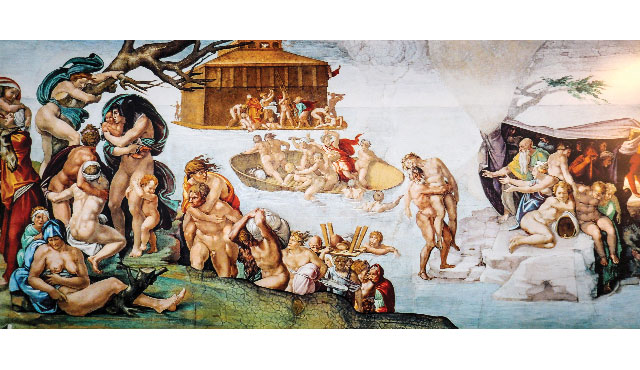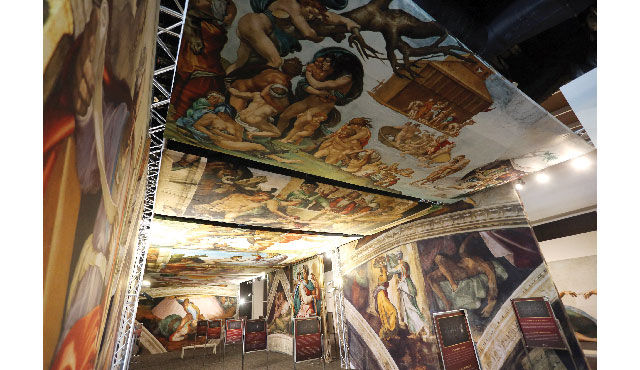The centerpiece of the Sistine Chapel ceiling, the Creation of Adam, is so compelling it inadvertently directs one’s gaze away from the other masterpieces surrounding it. Among these is the fresco known simply as The Flood. It is the most chaotic, complex panel on the ceiling. With over 50 characters packed into the frame no other ceiling depiction matches the number of characters as that of The Flood.
In the faces of those in this panel created over 500 years ago, one sees echoing across the centuries the situations encountered by those in this century’s refugee crisis, with thousands displaced from their home by war and poverty. When Pope Francis visited Lampedusa, the Italian island in the Mediterranean and often the primary point for entry into Europe from Africa, the pontiff wanted to draw attention to the perils endured by those seeking access to Lampedusa. Indeed, three months after the pope’s visit, in October 2013, a boat from Libya carrying migrants sank en route to Lampedusa. More than 360 deaths were reported.
Michelangelo’s “Flood” panel depicts a world torn asunder, engulfed in a looming catastrophe. The tension in the frame is palpable, the silence of desperation only punctuated by cries of helplessness and the ominous rumble of thunder. A storm is coming, one that will reshape the world. Here, all the world’s inhabitants become refugees, and all, aside from those in the Ark, will perish. The Flood depicts a war zone, the last moments of humanity fleeing for safety wherever they can, yet with nowhere to go. The effects of original sin coat the panel; this is what a world without God looks like.
Pope Francis posed this thought during his homily at Mass in Lampedusa, July 8, 2013: “How many of us, myself included, have lost our bearings; we are no longer attentive to the world in which we live; we don’t care; we don’t protect what God created for everyone, and we end up unable even to care for one another!” This indifference is captured by Michelangelo in The Flood by his several depictions of violence. A figure tries to climb aboard a small boat, but a man rears his fist back ready for a punch while a woman raises a club about to strike. In the fresco’s background is the Ark itself. Here, too, are desperate attempts to climb aboard as if the Ark is a castle besieged.
But the most compelling aspect of the panel is on the left-hand side where 20 figures seek dry land. Men, women, and children labor up a hill, scrambling to free themselves from the turmoil of the rising waters behind them. Michelangelo depicts each character differently, such as the woman balancing an upturned stool replete with dishware and bread. The Flood panel is as real-life as an image captured by a war photographer. It is almost as if Michelangelo is recreating an actual evacuation he may have personally witnessed.
Michelangelo’s unfinished Battle of Cascina, undertaken in Florence with only the sketch completed, served as a precursor to the movements and motions he brought to characters in The Flood. Yet the painstaking attention to detail on this fresco took up precious time. It was the first ceiling panel Michelangelo and his crew tackled in the Sistine, but the last to feature so much action. The succeeding panels, while no less epic in theme, were far less ambitious technically.
“Has any one of us grieved for the death of these brothers and sisters? Has any one of us wept for these persons who were on the boat? For the young mothers carrying their babies?” Pope Francis asked in Lampedusa. “We are a society which has forgotten how to weep, how to experience compassion — ‘suffering with’ others: the globalization of indifference has taken from us the ability to weep!”
Indifference to God, disdain for the divine and disregard for fellow man brought about the first deluge, when evil reigned in the hearts of men (Gen. 6:5). Pope Francis has identified “the globalization of indifference” as a prime malady of our own time, particularly indifference to those who need the most help. At the World Meeting of Families in Ireland, Francis set forth a challenge to transform one’s entire worldview into loving the way Christ loved. “[This] love alone can save our world from its bondage to sin, selfishness, greed and indifference to the needs of the less fortunate.”
Often God is a remote figure in our everyday lives. But because God is the Creator of heaven and earth, everything around us is a product of God’s creation. Everything humanly made and every natural thing, including, and especially, human beings. This, therefore, makes God someone very close and intimate.
He promised a flood would never strike down humanity as one did here (Gen. 9:15). The chaos of the modern world offers an opportunity to display true compassion for those tossed about by the waves of indifference.


